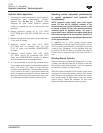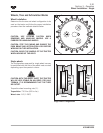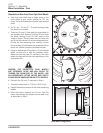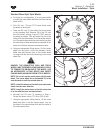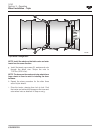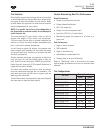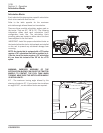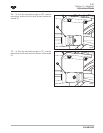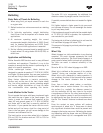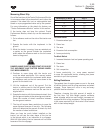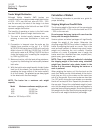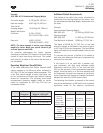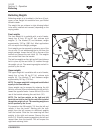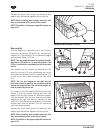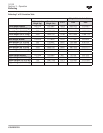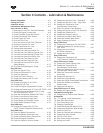
3-98
435/485/535
Section 3 - Operation
Ballasting
The extra 5% is to compensate for additional tire
distortion caused by weight transfer from the hitch.
If possible, remove ballast when not needed for lighter
loads.
Pull lighter loads at a faster speed to do more work
and increase efficiency. Do not overweight the tractor
to pull very heavy loads.
If the implement cannot be pulled at the needed depth
at 7.2 KPH (4.5 MPH) or greater, the implement is
over matched for your tractor.
The best guide to follow in ballasting is to not have the
full load wheel slippage fall below 12%.
This amount of slippage is your best protection against
overloading.
Wheel Slip
Wheel slippage is a vital consideration in any farming
operation. Too much slippage represents lost time
and wasted production. Too much wheel slippage is a
major cause of wheel traffic-induced soil compaction.
Too little can result in reduced reliability of the
drivetrain.
Strive for 8% to 15% wheel slippage on a 4WD.
Wheel slip is defined as the amount of tire rotation
“wasted” during one complete rotation of a tire.
Wheel slip is not a deterrent to tractor operation. It
is a necessary function of the tires and helps prevent
damage to the tractor drivetrain due to tractor
overload.
Every time a tractor wheel makes a revolution,
the wheel covers a certain distance. On a very firm
dry surface (i.e., asphalt), the distance covered in
one tire revolution will be very close to the actual
circumference of the tire. On a very loose surface (i.e.
sand), the distance covered in one tire revolution will
be significantly less than the actual circumference of
the tire. This “wasted” distance is referred to as wheel
slip.
Every tire contact on every surface will produce
some amount of wheel slip. If there were no wheel
slip, significant drivetrain wear would be present and
damage to the tractor may occur. Ballasting the tractor
and operating with the proper size and inflated tires
will maintain wheel slip at a manageable level (8%-
15%).
Ballasting
Basic Rules of Thumb for Ballasting
1. When using fluid, put equal amounts in each tire
on a given axle.
2. Ballast tractors to a minimum amount as a starting
point.
3. For light-duty application, weight distribution
front to rear is not as important as in heavier draft
applications.
4. At maximum operating weight, the correct
recommended weight distribution of 55/45 (front/
rear) for drawbar applications and 65/35 (front/
rear) for 3-point hitch applications is essential.
5. Set tire inflation pressures based on weight carried
by each wheel. Do not go below 55 kPa (8 PSI) on
radial tires.
Application and Ballasting
Buhler Versatile 4WD tractors work in many different
conditions and operations. Therefore it is up to the
operator to ensure that the tractor is performing at its
peak in its specific operations.
Unlike crawler-type tractors, these tractors are
designed to operate at speeds of 7.2 KPH (4.5 MPH)
and higher. At these speeds, they are more productive
and are less likely to have mechanical breakdowns.
Many factors determine a tractor’s productivity.
Factors such as the size of the load, tractor wheel
slip, tire rolling resistance, tractor operating weight
and tractor weight distribution all must be taken
into consideration when operating this tractor.
Loads Matched to the Tractor
Do not operate the tractor with heavy implement loads
that need the use of gears in the lower ranges. The
tractor is made for continued field operation at the
rated HP and ground speed of 7.2 KPH (4.5MPH)
and faster with a load that is correctly matched to
the tractor. If you operate the tractor with too much
ballast and pull too heavy a load for a long period of
time in the low gears, you will cause damage to the
drivetrain and decrease tire life.
The best traction occurs when wheel slip is between
8% and 15% for drawbar work and 13% to 15% for
3-point hitch work.



